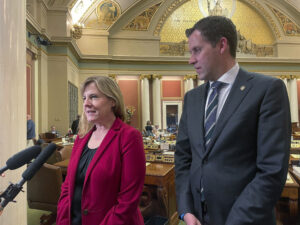Navel-Gazing in the Grand Old Party
While Republicans are looking inward and focusing on appeals to the party's activist base, Obama wants Democrats to concentrate their energies on recently acquired political terrain and the new converts who were central to his party's sweep last year.The message sent over the weekend may have been unintentional, but it was nonetheless powerful.
While the candidates to chair the Republican National Committee prepared for a debate on Monday sponsored by Americans for Tax Reform, a Reagan-era group, the Democrats leaked word that their next national chairman would be Gov. Tim Kaine of Virginia.
The message: While Republicans are looking inward and focusing on appeals to the party’s activist base, President-elect Barack Obama wants Democrats to concentrate their energies on recently acquired political terrain and the new converts who were central to his party’s sweep last year.
Of course, one can be too grand about the business of who leads a party’s national committee. Obama, not Kaine, is the real head of the Democratic Party. Governors and members of Congress, not the national committee chair, will define the next Republican Party. Moreover, the offer of the national chairmanship to Kaine was widely interpreted as a kind of consolation prize for one of Obama’s earliest and most fervent supporters.
But that understates the meaning of the choice. A top Obama adviser, using trademark Obama language, described Kaine as “a pragmatic progressive, less concerned about orthodoxies than about getting things done.”
In fact, Obama is already following the path blazed in Virginia by Kaine and his predecessor, incoming Sen. Mark Warner. Their approach was to pursue broadly progressive policies in a non-ideological way and to speak of downplaying partisanship — even as doing so was their way of building the Democratic Party’s brand and broadening its base of support.
Obama’s initial meetings on Monday about his stimulus package (and the incoming president’s decision to go to Capitol Hill and not have congressional leaders come to him) were designed to send a strong message of collaboration.
By contrast, Republicans seem less focused on how to expand their party’s appeal than on hunkering down to preserve ideological purity. For now, the underdogs in the chairmanship fight seem to be the two candidates outside the party’s regional and ideological comfort zones, former Maryland Lt. Gov. Michael Steele and Michigan state Chairman Saul Anuzis.
They confront two Southerners, Chip Saltsman of Tennessee, now most noted for distributing the CD that included the “Barack the Magic Negro” song, and Katon Dawson, the South Carolina party chairman. The incumbent, Mike Duncan of Kentucky, is seeking re-election, while former Ohio Secretary of State Kenneth Blackwell has emerged as the candidate of the conservative stalwarts.
Structurally, it turns out to be much easier for Democrats than Republicans to reach out to moderates because Democrats are the more ideologically diverse party.
I asked Jon Cohen, director of polling for The Washington Post, to use the 2008 media exit poll to break down last November’s electorate by party and ideology.
In one sense, Republicans have the larger core base — 21 percent of voters called themselves conservative Republicans, while only 15 percent saw themselves as liberal Democrats.
But there are many more moderate Democrats than moderate Republicans: 18 percent of all voters considered themselves moderate Democrats, while only 10 percent thought of themselves as moderate Republicans. (Five percent of voters called themselves conservative Democrats and only 1 percent called themselves liberal Republicans, who, sadly, are a dying breed.)
Thus, when Democrats try to broaden their appeal, they are also addressing middle-of-the-road voters in their own party. Republicans who want to reach out have to fight their party, which is overwhelmingly inclined to stick with the true conservative faith.
Republicans would do well to pay attention to another trend: The young are leaning left. Voters under 30, according to the exit poll, are the only age group in which liberals outnumber conservatives, by a margin of 32 percent to 26 percent.
And the last four years of the Bush presidency clearly turned this generation off to the GOP. In 2004, 18- to 29-year-olds tilted only narrowly Democratic, 37 percent to 35 percent. In 2008, 45 percent of the under-30s called themselves Democrats; only 26 percent called themselves Republican.
Right-wing loyalists can talk all they want about how President Bush’s problem was that he wasn’t “conservative enough,” but the numbers show they are misunderstanding their party’s problem. Obama and Kaine are appealing to a moderate country moving gradually in a progressive direction, and have a party behind them prepared to grapple with the realities of politics now.
Whoever takes the helm of the GOP will have to persuade a very conservative following that we are not living in Ronald Reagan’s America anymore.
E.J. Dionne’s e-mail address is postchat(at)aol.com.
© 2009, Washington Post Writers Group
Your support matters…Independent journalism is under threat and overshadowed by heavily funded mainstream media.
You can help level the playing field. Become a member.
Your tax-deductible contribution keeps us digging beneath the headlines to give you thought-provoking, investigative reporting and analysis that unearths what's really happening- without compromise.
Give today to support our courageous, independent journalists.






You need to be a supporter to comment.
There are currently no responses to this article.
Be the first to respond.